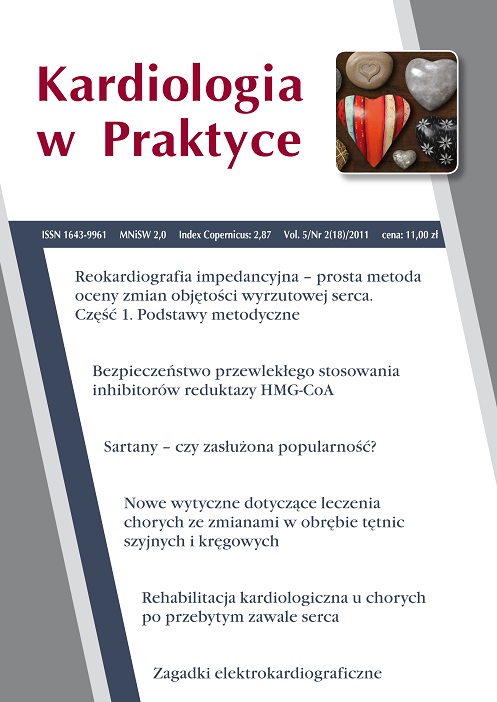Safety issues of long term treatment with statins Review article
Main Article Content
Abstract
Statins are nowadays one of the most commonly used drug group. In past decades it has been proven that statins reduce cardiovascular risk in both primary and secondary prevention. Although generally well tolerated those drugs have some adverse effects. In this article authors describe shortly the most dangerous adverse effects: myopathy and hepatotoxicity. They also refer to latest data as far as the increase of risk of new onset diabetes in patient receiving statins is concerned. Finally they refer to the lack of correlation between statins and the risk of cancers.
Downloads
Article Details

This work is licensed under a Creative Commons Attribution-NonCommercial-NoDerivatives 4.0 International License.
Copyright: © Medical Education sp. z o.o. This is an Open Access article distributed under the terms of the Attribution-NonCommercial 4.0 International (CC BY-NC 4.0). License (https://creativecommons.org/licenses/by-nc/4.0/), allowing third parties to copy and redistribute the material in any medium or format and to remix, transform, and build upon the material, provided the original work is properly cited and states its license.
Address reprint requests to: Medical Education, Marcin Kuźma (marcin.kuzma@mededu.pl)
References
2. Bryl W., Pupek-Musialik D.: Statyny: obecny stan wiedzy, rola w prewencji i terapii schorzeń układu sercowo-naczyniowego. Przew. Lek. 2006, 6: 98-105.
3. Wełnicki M., Mamcarz A.: Statyny w praktyce – pytania i odpowiedzi. Medical Education, Warszawa 2011.
4. Sattar N., Preiss D., Murray H.M. et al.: Statins and risk of incident diabetes: a collaborative meta-analysis of randomised statin trials. Lancet 2010 Feb 27; 375(9716): 735-42.
5. Hippisley-Cox J., Coupland C.: Unintended effects of statins in men and women in England and Wales: population based cohort study using the QResearch database. BMJ 2010 May 20; 340: c2197 [online: doi: 10.1136/bmj.c2197].
6. Mach T.: Statyny a ryzyko uszkodzenia wątroby. Przegląd Gastroenterologiczny 2007; 2(2): 111-115.
7. Denus S., Spinler S.A., Miller K. et al.: Statins and liver toxicity: a meta-analysis. Pharmacotherapy 2004; 24: 584-91.
8. Maddrey W.C.: Drug-induced liver disease: 2006. The risk profile of statins. American Association for the Study of the Liver Diseases. Annual Meeting, Boston, 2006.
9. Małecki R.: Rabdomioliza – postępowanie w warunkach opieki podstawowej. Kardiologia na co Dzień 2007, 2(2): 64-68.
10. Cannon C.P.: Balancing the benefits of statins versus a new risk-diabetes. Lancet 2010 Feb 27, 375(9716): 700-1 [online: DOI:10.1016/S0140-6736(09)60234-6].
11. Cholesterol Treatment Trialists’ (CTT) Collaborators. Efficacy and safety of cholesterol-lowering treatment: prospective metaanalysis of data from 90 056 participants in 14 randomised trials of statins. Lancet 2005, 366: 1267-78.
12. Shepherd J. et al.: Safety of Rosuvastatin: Update on 16,876 Rosuvastatin-Treated Patients in a Multinational Clinical Trial Program. Cardiology 2007, 107: 433-443.
13. Barylski M.: Rosuwastatyna. Biblioteka pisma „Cardiology Journal”. Via Medica, Gdańsk 2010.

